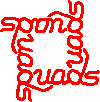
ARTICLES
About Quads
Jargon
Etiquette
Swinging Tips
Hand Positioning
Dance Attire
Hoedowns
Festivals
Levels and Lists
Advice for the New Graduate
What Makes a Good Dancer
Advice for Angels
Stanford Quads
Square Dance Club
Advice for Angels
by Bill van Melle, September 17, 1995
Please read through this list and keep it in mind, even if you think you've heard it all before, as the success of the class depends as much on the attitude of the club as on the talent of the students. Much of this advice is appropriate in any square dance situation, but it's especially so with newer dancers.
Be friendly
We want the new dancers to have a good time, so please make them feel welcome. Ask them to dance with you, rather then letting them fend for themselves. Talk to them during the breaks.
Don't push
This is a special case of being friendly. If a class member is unsure of a call, some of you angels may experience a great temptation to grab the person and push him or her into position. Don't do this! Really. DON'T PUSH! Gad, I hate to use all caps like that, but this is really important. At the very least, this is simply rude behavior. Remember, the object is not for you to get through the sequence; it's for the class members to learn. They don't learn by being shoved.Do your best to be in the right position yourself, hold out your hand expectantly and/or exert gentle (I repeat, gentle) hand pressure consistent with the flow of the call, but never, never grab or shove. It is far better to let your square break down than to start shoving people around to fix it. Squares breaking down is great feedback to the caller about what moves the dancers are having trouble with. If you observe others shoving people around (sometimes there are visiting angels who fancy themselves good dancers by the amount of pushing they do), please take them aside after the tip and encourage them to behave themselves.
If someone is already in the right position, but is looking around frantically as if lost, the best thing you can do is nod and smile. Not that you shouldn't be smiling even when the square is breaking down...
Balanced squares
If you can do so unobtrusively, attempt to balance the number of club and class members in a square. Experienced dancers in a square help to be good examples (please do), and reduce the likelihood that one dancer's error will take down the whole square, depriving the other dancers of practice. The problem that arises time and again is that club members remember that it's important for class members to dance, and as a result neglect to square up at all until they're dragged from the sidelines to fill out the last square. Of course, that square ends up being club-heavy, while the class members in their enthusiasm have already formed very class-heavy squares. Don't let this happen--get out there when the music starts! One of the best ways to achieve balance is to preferentially ask class members to be your partner. Just think--if every class member was partnered with a club member, we'd automatically have balanced squares.
Class members have priority
Remember, they're here to learn, and so they need to dance. But many are shy, or not completely comfortable yet asking for a dance. If you see a class member sitting out, offer to give up your spot in the square, especially if you're in a club-heavy square. Of course, if you all do your job of asking class members to dance with you, we won't need to go bumping club members like this.
Don't play caller
Sure, you can whisper small hints to people who are momentarily confused, but while a tip is in progress, don't try to do any major teaching or fixing on your own (and if you're on the sidelines, don't jump into the square trying to help). There's already a caller up front with a microphone, and we'd like to train new dancers to pay attention to him. Reserve lengthier problem solving to breaks.
No frills
Never initiate a frill with a class member. In fact, don't even do them with club members during class tips. Frills make dancing more fun, but interfere with learning, even if a class member is not directly involved in your frill. Save your frills for the club tips at the end of the evening. Class members typically don't get interested in frills until December or January. Examples of frills are the twirl on Weave the Ring, the highland fling Do Sa Do, and the swing in the middle of Sides Promenade Halfway Round. And please dance hands up, at least for the class--it's still the standard styling for Plus in this area.
Last updated Wednesday 8 August 2007